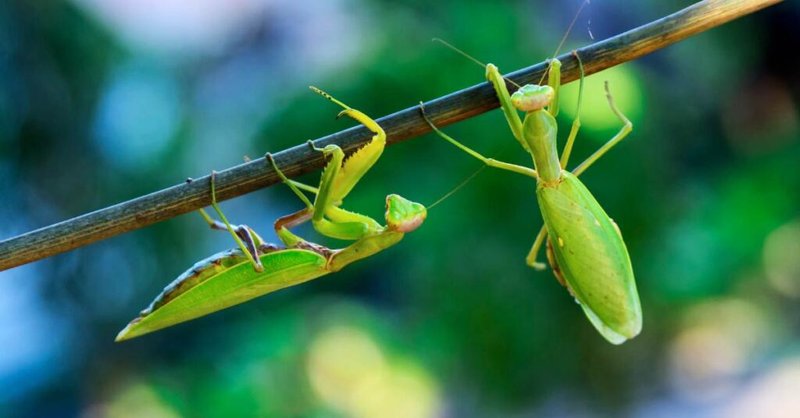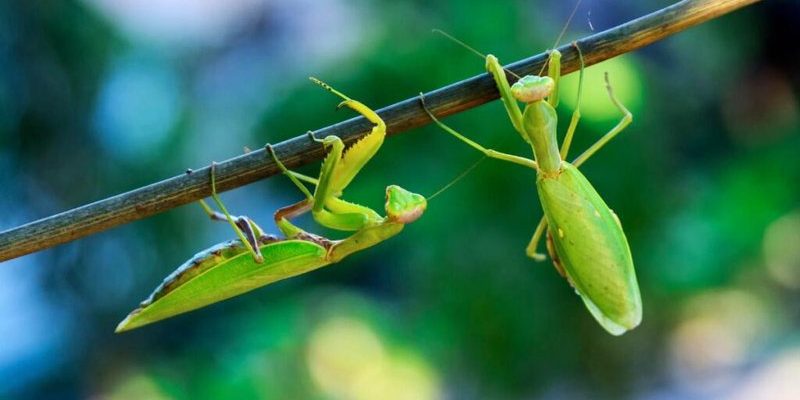
Picture this: You’re at a café, and you watch a couple of friends having a lively chat. They’re using hand gestures, body language, and even their faces to express feelings and ideas. Now, swap those friends for praying mantises, and it’s not too different! These creatures have their own methods to convey messages, whether it’s to find a mate, scare off predators, or establish territory. Let’s dive into the fascinating world of how praying mantises communicate and interact.
Visual Signals: The Language of Movement
One of the most striking ways that praying mantises communicate is through visual signals. Their body language tells a story, just like a person might use gestures during a conversation. For instance, when mantises want to show aggression, they may raise their forelegs in a threatening stance. This is their way of saying, “Back off!” If you’ve ever seen a mantis puff itself up, it’s like they’re trying to make themselves look bigger and more intimidating.
Moreover, these insects can change their posture depending on the situation. When a female mantis is ready to mate, she might display certain movements or positions to attract a male. It’s a bit like a dance, with each movement signaling readiness or caution. This dance isn’t just about attracting mates; it’s also about survival. The ability to read these visual cues helps them navigate the complex world they live in, avoiding predators while seeking partners.
Color and Camouflage
Another layer of visual communication among mantises involves color and camouflage. These clever insects are experts at blending into their surroundings. Whether they mimic leaves, stems, or flowers, their colors and patterns help them hide from predators and ambush prey. When they change their positioning or color slightly, it’s not just for disguise; it can also signal other mantises. Imagine two friends playing hide and seek—sometimes, a slight movement or change can give away their position!
Being skilled at camouflage allows mantises to stay safe while also interacting. For example, a mantis hiding in a flower might attract pollinators. The colors not only serve as protective features but also play a role in communication, allowing prey and mates to notice them while others don’t.
Chemical Signals: The Scent of Communication
Besides visual signals, praying mantises also use chemical signals, often in the form of pheromones. Pheromones are like invisible messages floating through the air, carrying information about readiness to mate or warn of danger. When a female is ready to mate, she releases pheromones that can attract males from quite a distance.
This chemical communication is especially useful since mantises may not always be in a direct line of sight. Imagine sending a text message to a friend—it’s another way to connect, even when you’re not right next to each other! Through these scents, mantises can ensure they find the right partner, enhancing the chance of successful mating and, ultimately, the continuation of their species.
Territorial Markings
In some cases, mantises use pheromones to mark territory. When a male mantis sets up shop in a prime location, he might leave behind a scent that signals, “This spot is taken.” Other mantises that pick up on this scent might steer clear. It’s a smart way to avoid conflict and keep peace in a crowded environment.
This behavior is critical for survival, especially in areas where food sources are competitive. By communicating their territory chemically, mantises can focus on hunting and mating instead of fighting with their neighbors.
Sound Communication: The Subtle Art of “Talking”
Believe it or not, praying mantises can produce sounds, too—although it’s not as common as their visual and chemical communication methods. They create soft sounds through a process called stridulation, which involves rubbing body parts together, similar to how crickets chirp. This method may be used to attract mates or warn off rivals.
While these sounds aren’t the loudest or most noticeable, they play a role in their communication toolkit. It’s a bit like whispers in a crowded room—you might not hear them at first, but they can carry important messages if you’re listening closely.
Interactions During Mating
When it comes to mating, the subtle sounds and visual cues combine. Males will often perform elaborate displays while making soft sounds to woo females. This courtship behavior can be a delicate dance, as mantises are known for their unique mating habits, including potentially eating the male after mating. It’s a risky business, but this interaction shows how important communication is in their mating strategy.
Understanding these interactions can give us a glimpse into the complex emotional and social life of these insects. Their “conversations” involve a mix of caution, attraction, and sometimes, danger.
Social Behavior: Solitary or Social?
Praying mantises are primarily solitary creatures, but that doesn’t mean they don’t interact with each other. They often come together during mating seasons, while juveniles may stay close to their hatching site. It’s interesting to see how their social behavior shifts depending on the time of year and their life stages.
While they might not form groups like some other insects, mantises can exhibit a kind of social hierarchy when it comes to territory and resources. For example, larger males tend to dominate certain areas, while smaller ones might have to be more cautious. It’s a bit like a small town where everyone knows their place, and being aware of each other’s presence is crucial for survival.
Interactions with Other Species
Praying mantises also interact with other species, often as predators. They are known for their ambush hunting style, waiting patiently for unsuspecting prey to come within reach. This interaction isn’t just about feeding; it also involves sending signals to their potential prey through movement and posture. For instance, a mantis may sway gently, mimicking vegetation, to lure in a meal.
While they mostly focus on insects, mantises have been known to catch small birds and reptiles, showcasing their adaptability. In these moments, communication is less about sending messages and more about skillfully interacting with their environment to secure food.
Understanding Mantises: Why This Matters
So, why should we care about how praying mantises communicate? Understanding their interactions helps us appreciate the complexity of life in the insect world. It reminds us that communication isn’t just a human trait—it’s a vital part of survival for many species.
By learning about mantises, we can gain insights into the ecosystem around us. These insects play essential roles in controlling pest populations, which can benefit gardens and farms. The more we understand them, the better we can protect their habitats and ensure they thrive.
In conclusion, praying mantises have developed a rich tapestry of communication methods, from visual signals and chemical messages to subtle sounds. Their interactions are as complex as any social creature’s, showcasing a deep connection to their environment and fellow mantises. By observing these behaviors, we not only learn about the insects themselves but also about the intricate balance of nature.
Next time you spot a mantis, take a moment to appreciate the little nuances of its communication. These extraordinary insects are more than just predators; they’re a vital part of a larger story within our ecosystem. Whether it’s through a dance, a scent, or a quiet whisper, the world of praying mantises is truly captivating.

